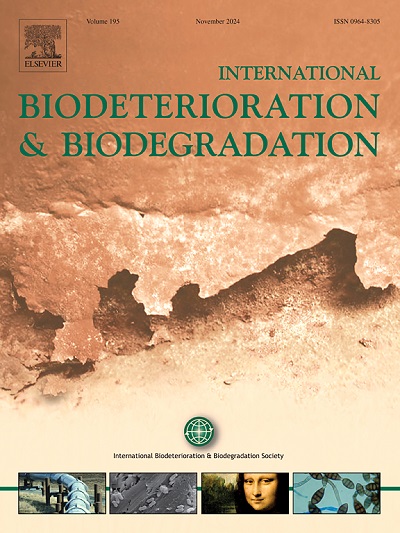不同添加剂对atroviide木霉G79/11生长强度及代谢活性的影响
IF 4.1
2区 环境科学与生态学
Q2 BIOTECHNOLOGY & APPLIED MICROBIOLOGY
International Biodeterioration & Biodegradation
Pub Date : 2025-04-23
DOI:10.1016/j.ibiod.2025.106104
引用次数: 0
摘要
毛霉菌种有能力作为一种安全、可持续的环境方式来提高作物产量和应对病原菌多样性。通过高效、准确的方法,利用新型营养源来评估和提高其生长强度和代谢活性是一项至关重要的任务。在本研究中,使用 Biolog MT2 微孔板评估了在果胶组分(水溶性果胶-WSP、稀释碱溶性果胶-DASP 和草酸溶性果胶-OSP)和细菌纤维素(BC)等多糖添加剂以及无机盐强化剂存在下 T. atroviride G79/11 的生长强度和代谢活性。果胶是水果和蔬菜工业废料中的重要成分,而细菌纤维素则具有超强的保水能力,这两种物质首次被用来刺激阿特柔菌 G79/11 的生长。在添加了钙、锌、镁和铁的 WSP 和 OSP 分馏物中观察到,T. artoviride G79/11 的代谢效率最高。据记录,葡萄糖是 BC 组成的主要成分,而半乳糖醛酸在 OSP、WSP 和 DASP 组分中的含量最高,分别为 84.53%、7.56% 和 71.70%。应用的多糖溶液在粘度上存在明显差异,这也受到灭菌过程的影响。在添加了 WSP、BC、ZnCl2、糖、葡萄糖、淀粉和 OSP 与 CaCl2 添加剂组合的马铃薯葡萄糖肉汤中,菌株的生长强度和代谢活性明显高于其各自的组别和组合以及 FF-IF。该研究强调,天然多糖及其可能的复合材料可提高真菌菌株的生长强度和代谢活性。本文章由计算机程序翻译,如有差异,请以英文原文为准。

Evaluation of Trichoderma atroviride G79/11 growth intensity and metabolic activity under different additives using Biolog system
Trichoderma species have the ability to act as a safe and sustainable environmental way to enhance crop productivity and deal with pathogenic diversity. It is a crucial task to evaluate and boost their growth intensity and metabolic activity through an efficient and accurate method with novel nutritional sources. In the current study, Biolog MT2 microplates were used to evaluate the T. atroviride G79/11 growth intensity and metabolic activity in the presence of polysaccharide additives such as pectin fractions (water-soluble pectin-WSP, diluted alkali-soluble pectin-DASP, and oxalate soluble pectin-OSP) and bacterial cellulose (BC), fortified with inorganic salts. Pectin, as a significant component of fruit and vegetable industry waste, and bacterial cellulose, which has an exceptional water retention capacity, were used for the first time to stimulate the growth of T. atroviride G79/11. The highest metabolic efficiency of T. artoviride G79/11 was observed in WSP and OSP fractions supplemented with Ca, Zn, Mg and Fe. Glucose was recorded as a dominant constituent of BC composition, whereas galacturonic acid was detected with the highest amount of 84.53 %, 7.56 %, and 71.70 % of OSP, WSP, and DASP fractions, respectively. Applied polysaccharide solutions significantly differed in viscosity, which was also influenced by the sterilization process. The strain showed significantly high growth intensity and metabolic activity in potato dextrose broth amended with WSP, BC, ZnCl2, saccharose, glucose, starch, and a combination of OSP with CaCl2 additive as compared to its respective groups and combinations as well as FF-IF. This study emphasizes that natural polysaccharides and their possible composites can boost the growth intensity and metabolic activities of the fungal strain.
求助全文
通过发布文献求助,成功后即可免费获取论文全文。
去求助
来源期刊
CiteScore
9.60
自引率
10.40%
发文量
107
审稿时长
21 days
期刊介绍:
International Biodeterioration and Biodegradation publishes original research papers and reviews on the biological causes of deterioration or degradation.

 求助内容:
求助内容: 应助结果提醒方式:
应助结果提醒方式:


